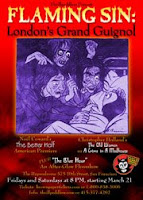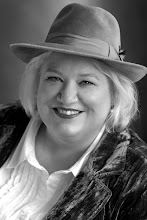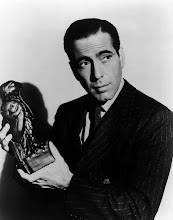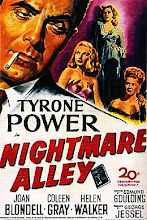 At Noir City this year, we were treated to a special evening of programming saluting Richard Widmark, the "last man standing" from the classic noir period.
At Noir City this year, we were treated to a special evening of programming saluting Richard Widmark, the "last man standing" from the classic noir period.
Two superlative films were shown, one arguably Widmark's very best (and one of the best noir films, ever): Night and the City. Roadhouse, a jaunty little number co-starring Ida Lupino and Cornel Wilde, was the second half of the bill (reviewed here at Writing in the Dark).
As most of you undoubtedly know by now, Richard Widmark passed away on Wednesday, March 26. He was 94. With him vanished an era.
We lose so many of the great ones, year after year. And Widmark was one of the greatest. He was an actor who never should never have achieved stardom, if being a star meant handsome in the square-jawed fashion of 50s idols, with a barrel chest and cleft chin.
He was, by all accounts, a gentle, thoughtful, intellectual man, an old-fashioned liberal, who liked simple pleasures and the honesty of the outdoors. He abhorred violence of any kind; it is said he fished once, and hated killing the trout, and never did so again. And yet he will be forever remembered as Tommy Udo, the maniacal sociopath of Kiss of Death. A small part that Widmark made into a legend, and helped define what came to be called film noir. Who can forget that laugh of his, heard for the first time on screen (in all its glory) in Kiss of Death, but actually created when Widmark was a busy, popular radio actor in shows like Inner Sanctum or Gangbusters? Once heard, never forgotten.
Who can forget that laugh of his, heard for the first time on screen (in all its glory) in Kiss of Death, but actually created when Widmark was a busy, popular radio actor in shows like Inner Sanctum or Gangbusters? Once heard, never forgotten.
It was a gleeful laugh, unbridled and infectious, and usually built to a crescendo of hysteria right before his character left the stage ... exeunt. But even when playing a sociopath, or maybe especially because he was playing a sociopath, Widmark was able to elicit sympathy and commiseration and (scarily) identification with the audience that made even Tommy Udo seem, well ... cute.
That, folks, takes a lot of talent. And charisma. And Widmark had both in spades.
Just take a look at this list of movies, and if you haven't seen one, put it on your list ... No Way Out (chilling, affecting, unforgettable performance as a racist thug) ... Panic in the Streets (he's a good guy this time, scintillating, sweaty film) ... Don't Bother to Knock (with Monroe, and you still watch him) ... the heart-stopping Pick up on South Street (Thelma Ritter's best performance) ... Broken Lance ... Judgment at Nuremburg ... Cheyenne Autumn ... Murder on the Orient Express.
Noir, Western, Drama, Mystery, whatever the genre, Widmark fit right in. Even on I Love Lucy, when he guest-starred during the famous "Hollywood" cycle.
The classiest of actors. Never better than Night and the City, where his little boy grin and palpable vulnerability played to heights of tragic, noir chiaroscuro.
Widmark reportedly once commented, "I suppose I wanted to act in order to have a place in the sun. I'd always lived in small towns, and acting meant having some kind of identity."
Some kind of identity. And a certain place in the sun, one that brilliantly illuminates all the darkness--and humanity--of noir.
darkness--and humanity--of noir.
RIP, Richard Widmark, actor, gentleman, and gentle man. You are sorely missed.
Next week we'll be looking at Mitchum and Domergue. Meanwhile, if you have any favorite Widmark films or stories to share about this legendary actor, please post.
Sunday, March 30, 2008
Last Man Standing, R.I.P.
Posted by
Kelli Stanley
at
8:23 PM
0
comments
![]()
![]()
Labels: film noir, Kiss of Death, Night and the City, Richard Widmark
Sunday, March 23, 2008
A New Noel and the Grand Guignol!

What do Noel Coward, the quintessentially English satirist of upper crust British foibles (and author of theater classics like Private Lives) and a quintessentially French, gruesome, farcical 19th century theater of shocks and horror (as revived by the San Francisco Thrillpeddlers) have in common?
Eddie Muller. Yup, the Czar of Noir is back, out of the Castro Theater and in the Hypnodrome in San Francisco, demonstrating why he is not only an amazing cultural archaeologist, but a contemporary Renaissance Man.
A few weeks ago, Eddie gave me the preamble: The Better Half, a lost one act Noel Coward play had been recently discovered by University of Glamorgan scholar and historian Dr. Richard Hand, along with his colleague, Michael Wilson. Lurking in the files of Britain's Lord Chamberlain (the official censor of British theater), the 1921 comedy had actually been written as the comedy portion of a Grand Guignol production in London. Eddie was directing the AMERICAN PREMIERE. Yup, folks, not Broadway, not Stratford, not even Off-Off, or Off-Off-Off, but the Hypnodrome in Noir City won the right to re-premiere this lost Noel nugget. The Better Half would be the first half of a night of Grand Guignol, followed by Christopher Holland's The Old Women; or, A Crime in a Madhouse.
Give the Coward estate kudos: the chance to have the play performed within its original context won the Thrillpeddlers the bragging rights. And Eddie, who has specialized in premieres this year (as those who were lucky enough to see The Grand Inquisitor or The Prowler at a Noir City film festival can testify), took on the challenge.
And--of course--like everything Eddie touches, it came out gold. I was there last night, on the second preview of the show. The set design was nothing short of a miracle--this is a warehouse venue, after all, a tiny DIY theater. And yet the creative use of carved out flats suggested both a 1920s dadaist/deco impression of a well-bred London flat AND (in the second half) a decayed and forbidding (and ecclesiastical) French insane asylum. Programs weren't printed yet, so I unfortunately can't credit the phenomenal designer by name ... but the design was nothing short of genius.
So, too, was Eddie's use of it. He moved his cast of three actors around the tight, almost claustrophobic space and made it feel like one of those grand English drawing rooms in a 1930s screwball comedy. Cinematic flourishes and suggestive, flirtatious touches that underlined and perfectly punctuated the dry wit and fast-paced one-liners completely captured the Coward ambiance. The dialog coach Eddie brought in had done a remarkable job with the actors -- and even Mr. Muller sounded like a young Ronald Colman.
Eddie's terrific direction was enhanced by an amazing performance from an actress I hope we hear more from: Alice Louise. The Better Half is a three character comedy, with the figure of Alice, a frustrated wife, functioning as the centerpiece. Much of it flowed like a monologue, and without a truly gifted actress in this part, the play would've fallen flat. Alice Louise more than lived up to the tremendous challenges of the tiny venue and constricted stage: she seemed to channel Gertrude Lawrence in the sheer charm and virtuosity of her performance. I saw Judi Dench in Hayfever on the West End a couple of years ago; Alice Louise easily bested most of the actors in that production. She's an actress to watch.
Some of you may be wondering what Grand Guignol is ... the short version is that it was an actual theater in Paris' Montmartre that specialized in the sensational, emphasis on senses. Lots of horror, and all of it front of you, not off-stage. Eye-gouging, torture scenes, all the stuff you're now familiar with from Tales of the Crypt. It has exerted tremendous influence on entertainment of every stripe--from comic books to television to film and plays. Think Sweeney Todd or Whatever Happened to Baby Jane, and you'll get the idea.
actual theater in Paris' Montmartre that specialized in the sensational, emphasis on senses. Lots of horror, and all of it front of you, not off-stage. Eye-gouging, torture scenes, all the stuff you're now familiar with from Tales of the Crypt. It has exerted tremendous influence on entertainment of every stripe--from comic books to television to film and plays. Think Sweeney Todd or Whatever Happened to Baby Jane, and you'll get the idea.
The original plays, however, often contained a large dose of social commentary, and the second half of last night's double bill was no exception. Directed by Thrillpeddler's charming and demonically genial host, Russell Blackwood, the production was an extremely well-executed and well-acted (the young actress who portrayed the victim was a real stand-out) tale mixing grotesque, explicit violence with farce and a sharp critique of the Catholic church. While my personal tastes run toward a slightly more restrained approach in both film and live production, the Grand Guignol is something to experience, and everyone should be grateful to the Thrillpeddlers for keeping it alive with such style and verve.
Grand Guignol, after all, can be traced back to classical Greece, where plays featured women who dismembered their sons and men who blinded themselves after incest with their mothers. And the addition of the comedy element can be considered a satyr play, that brief foray into sex and comedy that Athenian playwrights wrote for the end of a long day of tragic fare.
So even if you're not particularly a fan of the Vault of Horror, troop down to the Hypnodrome on 10th street in San Francisco -- for a twenty dollar seat, you'll get a night of rich entertainment: a scintillating and brilliantly-directed new Noel Coward confection, and a stomach-churning, over-the-top George Romero-style French classic. How can you miss? By the way, a radio interview with Eddie and Dr. Hand will be broadcast on Tuesday on KALW, for those who want to hear more back story.
Next week: Return to noir, with Robert Mitchum and Faith Domergue in Where Danger Lives ... or, as I call it, Never Date a Suicide ...
Posted by
Kelli Stanley
at
1:04 PM
0
comments
![]()
![]()
Labels: Eddie Muller, Grand Guignol, Noel Coward, Noir City, premiere, The Better Half, Thrillpeddlers
Sunday, March 16, 2008
Left Coast Crime: Sunshine and Snowflurries

It's hard to believe that this time last week was the final day for that most winsome and winning of conferences, Left Coast Crime. What a whirlwind!
Luckily, Writing in the Dark (this blog, doncha know) had special guest and fabulous historical noir writer, Becky Cantrell, to keep the fires burning. We could've used a hearth or two in Denver, where the snow flurries drifted and spun down the eerily quiet 16th Street pedestrian mall, settling into small snow drifts, as powdery as your grandmother's compact.
I had a lot of fun at LCC, and over the next few days, I'm going to post some pictures to prove it. There were too many highlights to unwrap them all in one blog, even though I tried to hit a few high notes when I guested over at the ever cool Crime Always Pays blog of friend and top writer Declan Burke (also known as the Irish Elmore Leonard--his books are amazing!).
I met a lot of new friends, people I'd only met virtually ... like Robert Gregory Browne, an amazing writer from the Killer Year class who is an utterly wonderful guy to hang around with. J.T. Ellison, another KY alum, whom I felt like I'd known forever. Jeri Westerson (the creator of Medieval Noir with her Crispin Guest series, coming this fall) and I met in the signing room and talked about hard-boiled history and teaming up for a panel.
I met the wonderful Jeanne Stein over dinner, Margie Lawson, the amazing editor and writing coach. The delightful Toni McGee Causey. Tireless volunteer and the Birdwatcher's Mystery Series creator Christine Goff. And the list goes on, because the writing community really is a special one, filled with generous, fascinating and talented people, and even though I tried, I didn't get to share a drink with them all.
I hung around with panel mates and author friends from Northern California, like Cornelia Read (don't miss out on Crazy School!). I got to see out of state friends like Lost Dog author, Rocky nominee and KY member Bill Cameron (he who christened The Big Noo The Big Noo) ... Laura Benedict, the author of the fantastic Isabella Moon, and ITW Debut Program leader CJ Lyons, who launched her first novel Lifelines at LCC, a gripping medical thriller that is just one hell of a good book.
In other words, I was surrounded by amazing talent. And friends. And wonderful, wonderful readers, librarians, booksellers, publishers. In short, it was nirvana. In short, a hell of a conference.
readers, librarians, booksellers, publishers. In short, it was nirvana. In short, a hell of a conference.
Sunshine in the day; snow flurries at night; and a whirlwind of excitement, conversation, clinking glasses, scintillating panels, costume contests, and nonstop, crazy fun. Left Coast Crime. I can't wait til I can do it all over again in 2009 (albeit with no snow flurries).
Next up: more photos from LCC and news about a newly discovered Noel Coward play and Czar of Noir Eddie Muller! And hey--if you were there, or have ever been to a conference or ever thought about going to a conference--leave a comment! :)
Posted by
Kelli Stanley
at
8:12 PM
6
comments
![]()
![]()
Labels: Becky Cantrell, Bill Cameron, CJ Lyons, Cornelia Read, Crime Always Pays, J.T. Ellison, Jeri Westerson, Laura Benedict, Left Coast Crime, Lifelines, Robert Gregory Browne, Toni McGee Causey
Saturday, March 8, 2008
Real Travel
Hannah’s apartment? Gone. Her office? Still there and recently restored. It’s closer in appearance to where she worked than at any time since 1931, when she typed her make believe news stories there. Eerie, but very cool.
But eeriest of all was the gay bar El Dorado. It’s where Hannah’s brother Ernst, a drag queen decades before we invented the term, mesmerized audiences with his singing. The Nazis closed the actual bar after the elections in 1933, and, not skilled at recognizing irony, turned it into a political headquarter.
In the 1990s the bar reopened. When I ordered a Berliner weisse beer, my old college favorite, they only had raspberry red shots. I laughed, because that is all that Ernst would have ever ordered anyway, red being his signature color. At last, Ernst’s old haunt was restored, not as it was in real life, but as I invented it with him in my novel. Goosebumps raised on my arms as I studied the oil paintings that lined the walls. Reproductions of Georg Grosz’s Metropolis, each was a deja-vu-inducing scene from my book. El Dorado today looks less like it did in 1931, and more like a representation of the world I created in my novel. I wasn’t the only one who fell in love with Berlin in 1931 and tried to recreate it whole.
Again I sit on my lanai. This time I must imagine an even darker Berlin. In The Night of the Long Knives, Hannah and I have been drawn into the murderous Berlin of 1934. I step into its shadows. In spite of devoting years and pages to it, Berlin still won’t let me go.
Where would you travel to walk in the footsteps of your favorite literary character? What would be changed? What would be the same? And, most importantly, what would you snack on?
Posted by
Kelli Stanley
at
12:30 PM
3
comments
![]()
![]()
Labels: Berlin, Even Smoke Leaves a Trace, Rebecca Cantrell
Wednesday, March 5, 2008
Time Travel
With my heroine, Hannah Vogel, I moved into Berlin in 1931, the year before Germany was completely lost to the Nazis. I started at the top level of research with secondary sources, thick scholarly tomes like The Rise and Fall of the Third Reich, but only through page 387 because I wasn’t interested in the fall yet, just the rise. I romped through Otto Friedrich’s history of Weimar-era Berlin, Before the Deluge. And where else but in Hawaii would I have time to start the thousand year history of Berlin, Faust’s Metropolis by Alexandra Richie?
I listened to the rough voice of Lotte Lenya, widow of Kurt Weill, belting out an enchanting “Mack the Knife,” a song released in—you guessed it—1931 in Berlin. Now to see their world. Berlin’s UFA Studio was the center of the German film industry from 1917 to 1945. Amazingly gifted directors who worked there would later come to the United States and become famous enough that even their early films are available on Netflix, only a few days shipping from my tiny TV, classics like M, Emil and the Detectives, and Nosferatu.
It was pure self indulgence but, I wanted to taste the city too. I trekked to a specialty grocery store and brought home boxes of bockwurst, Berliner weisse beer, chocolate, and apple strudel mix. It wasn’t quite Berlin in 1931, but at least it was my Berlin from 1985. Writers get to have fun too.
How do you like to travel back in time? If you could travel any where and any when, where would you go, and what would you bring back?
Posted by
Kelli Stanley
at
3:26 PM
10
comments
![]()
![]()
Labels: Berlin, Even Smoke Leaves a Trace, German history, Rebecca Cantrell, Weimar
Sunday, March 2, 2008
Questions to Ponder ...

A short post this week, because we're in a whirlwind of activity getting ready for Left Coast Crime in Denver ...
There's promotional stuff to pack, clothes (and shoes and hats) to choose ... I sometimes wish (always when I'm packing) that I was one of those people who can throw any old wearable into an overnight bag and somehow emerge at a destination, refreshed and coiffed, and somehow make a stained sweatshirt look good.
Wait ... there really aren't people like that, are there? Stained sweatshirts never look good outside of an action movie.
Anyway, point is I have to give thought to what to pack, and thought (and packing) takes time ... and time is always in short supply. Tempus fugit, as Virgil pointed out (we owe so much to that man, and he still gets the short end of the stick compared to Homer. But at least he didn't have to suffer the ignominy of Brad Pitt playing his protagonist). But I digress ...
So before I leave you with a question to ponder for the week, until guest blogger and fantastic noir writer Rebecca Cantrell checks in, I wanted to tell you why Helen Mirren doesn't have to worry.
I watched E:GA in Seattle, and it's not that Cate Blanchett isn't one of the best actresses working today. It's that Elizabeth: the Golden Age was a ninety-odd minute film, not well.jpg) directed (enough with the spinning, apotheosized Virgin Queen, for God's sake!) and tried to fit a mini-series worth of content and character into one movie. In other words, like a lot of films, style was more important than substance and content. (Clive Owen swinging on a rope? Did we really need this? And I'm even a fan!)
directed (enough with the spinning, apotheosized Virgin Queen, for God's sake!) and tried to fit a mini-series worth of content and character into one movie. In other words, like a lot of films, style was more important than substance and content. (Clive Owen swinging on a rope? Did we really need this? And I'm even a fan!)
And when, oh when, will anyone ever get the "I may have the body of a weak and feeble woman, but I have the heart and stomach of a King" speech right? They stuck Glenda Jackson on a podium in the '70s; they had Helen picking up dirt balls and laughing with her troops as the Armada sailed (the only "huh?" moment in that series). Here, they don't use the the lines at all, though they at least put E. on a horse.
Well, enough of my grumbling. Lord, what fools these directors be. So here's your question to ponder: why is Paul Giamatti playing John Adams?
So here's your question to ponder: why is Paul Giamatti playing John Adams?
Look at the movie poster. And think about it.
Until next time, when I'm back from the Mile-High Thrill of Left Coast Crime, and posting about exciting new theater news in San Francisco!!
Posted by
Kelli Stanley
at
7:29 PM
0
comments
![]()
![]()
Labels: Cate Blanchett, Elizabeth I, Left Coast Crime, Paul Giamatti, Rebecca Cantrell

















